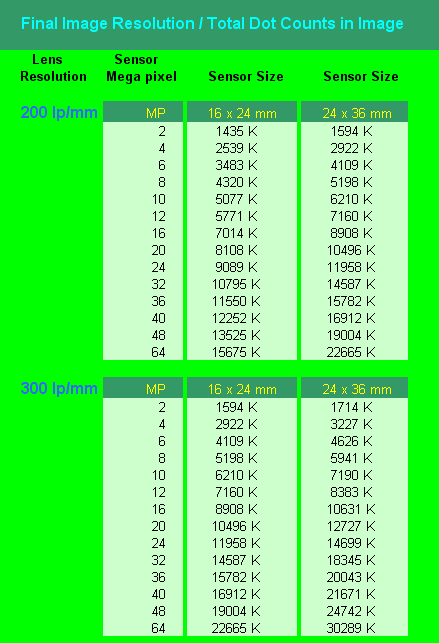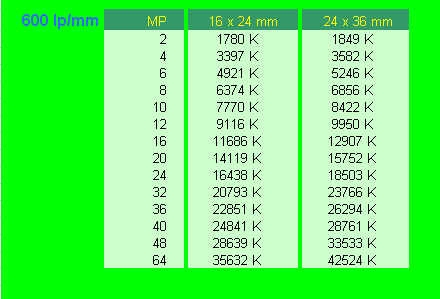|
Final Image Resolution
Back to Notes on Photography
General The table below shows the total number of dots (in terms of the final resolution) that are captured in the image. This is one ultimate measure of how sharp the picture can be. This is derived by calculating the final resolution (system resolution) at the image formed on the film, in this case, an image captured on the digital sensor. Then the resolution is multiplied by the size of the image sensor. The final resolution is a function of the lens quality used, the film resolution (chemical or digital) and the format size. The table is prepared for various lens resolutions (200 - 600 lp/mm), and for digital sensor mega pixel counts (from 2MP to 64MP). Also, we consider two image sensor sizes here, the full-frame 35mm format (24 x 36 mm), and the so-called DX-format (around 16 x 24 mm). It is seen from the table that the total dot counts are higher for the full-frame sensor for a given mega pixel (MP). Note that this difference due to the sensor size becomes less pronounced as the lens resolution increases. Note also that this disadvantage of the small sensor becomes more severe as the mega pixel count of the camera increases, relative to the lens resolution. Nikon's corporate decision to retain the DX-format (16 x 24 mm) for their flagship Nikon D2X is based on this theoretical analysis. Considering the Nikon D2X's 12 MP sensor, the dot counts difference between the full-35mm format and the DX-format is 5771K dots vs. 7160 K dots for the lens having a resolving power of 200 lp/mm. The difference becomes small er for the lens of 300 lp/mm resolution, and so on. The table also shows that if the DX-lens performs better than the traditional 35mm format lens, the difference could be overcome. For instance, a DX-format 12 MP sensor combined with a 300 lp/mm lens provides the same dot count of 7160 K dots as a full-frame 35mm 12 MP sensor using a 200 lp/mm lens. The lens resolution improvement of a modest degree is not unachievable, considering the small er image size requirement for the DX-format optics. These and other considerations led Nikon to stay with the DX-format for Nikon D2X -- at least for now. (See Future of DX format here.) I personally commend their decision, though I think the Nikon's move toward the full-35mm format digital SLR camera is inevitable, sooner or later, in order to compete with the full-frame DSLR cameras, such as Canon EOS 1Ds Mark II, EOS 5D, and some others. I predict Nikon to announce a full-35mm DSLR camera within a few years. There would be no technical hurdles, even today. Knowing Nikon for many years, however, I comfortably predict also that the Nikon will continue to maintain the DX-format line, that is, Nikon D3X, D4X, and so on and on, into the digital future......
|
| Carnivorous Plants Photography Web Site: Copyright © 2001-2018 Makoto Honda. All Rights Reserved. |


